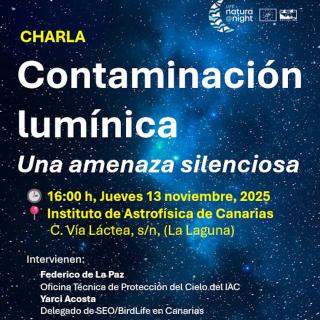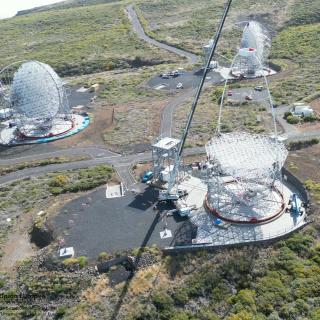It may interest you
-
 Especialistas abordarán el impacto de la iluminación artificial excesiva y sus efectos sobre la astronomía, la salud humana y la biodiversidad El Instituto de Astrofísica de Canarias (IAC) y SEO/BirdLife Canarias celebran la conferencia " Contaminación Lumínica: Una Amenaza Silenciosa", una jornada clave para la protección del medio ambiente y el patrimonio científico del archipiélago. La ponencia estará a cargo de Federico de la Paz, técnico del IAC, y Yarci Acosta de Seo/Birdlife, quien desgranará los graves riesgos que el uso ineficiente y descontrolado de la luz artificial supone para laAdvertised on
Especialistas abordarán el impacto de la iluminación artificial excesiva y sus efectos sobre la astronomía, la salud humana y la biodiversidad El Instituto de Astrofísica de Canarias (IAC) y SEO/BirdLife Canarias celebran la conferencia " Contaminación Lumínica: Una Amenaza Silenciosa", una jornada clave para la protección del medio ambiente y el patrimonio científico del archipiélago. La ponencia estará a cargo de Federico de la Paz, técnico del IAC, y Yarci Acosta de Seo/Birdlife, quien desgranará los graves riesgos que el uso ineficiente y descontrolado de la luz artificial supone para laAdvertised on -
 The four large sized telescopes of the CTAO on La Palma reach a key milestone in their construction The LST-2 telescope has successfully completed the installation of its camera support structure (CSS), making it the last of the four Large Sized Telescopes ( LST ) to reach this important milestone in its construction at the Roque de los Muchachos Observatory of the Instituto de Astrofísica de Canarias (IAC) on La Palma. This telescope is part of the ambitious CTAO ( Cherenkov Telescope Array Observatory ) project, which will create the world's largest network of telescopes for the detectionAdvertised on
The four large sized telescopes of the CTAO on La Palma reach a key milestone in their construction The LST-2 telescope has successfully completed the installation of its camera support structure (CSS), making it the last of the four Large Sized Telescopes ( LST ) to reach this important milestone in its construction at the Roque de los Muchachos Observatory of the Instituto de Astrofísica de Canarias (IAC) on La Palma. This telescope is part of the ambitious CTAO ( Cherenkov Telescope Array Observatory ) project, which will create the world's largest network of telescopes for the detectionAdvertised on -
 IAC researcher David Aguado has obtained a prestigious Starting Grant from the European Research Council (ERC), aimed at promoting promising young scientists. This is the third ERC grant -one of the most competitive and recognized of the Horizon Europe program- that the center has received so far this year, thus consolidating its international projection. These highly competitive grants provide up to €1.5 million over five years to support outstanding young scientists in establishing their own independent research groups and pursuing pioneering scientific ideas. Searching for the first starsAdvertised on
IAC researcher David Aguado has obtained a prestigious Starting Grant from the European Research Council (ERC), aimed at promoting promising young scientists. This is the third ERC grant -one of the most competitive and recognized of the Horizon Europe program- that the center has received so far this year, thus consolidating its international projection. These highly competitive grants provide up to €1.5 million over five years to support outstanding young scientists in establishing their own independent research groups and pursuing pioneering scientific ideas. Searching for the first starsAdvertised on
